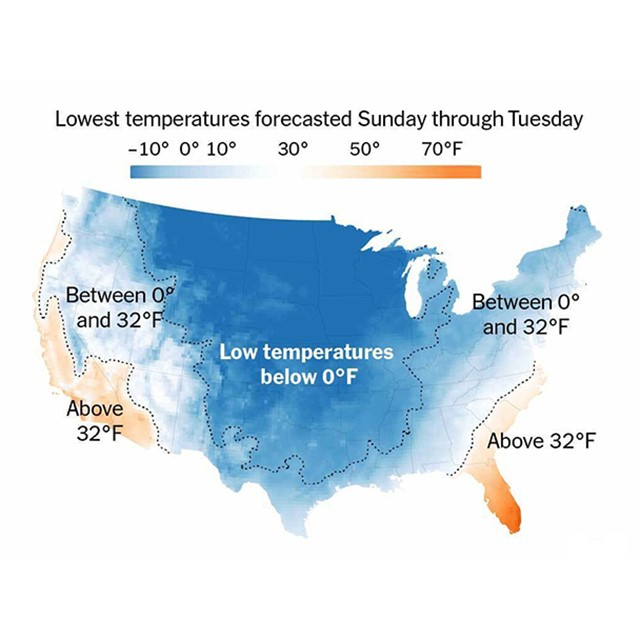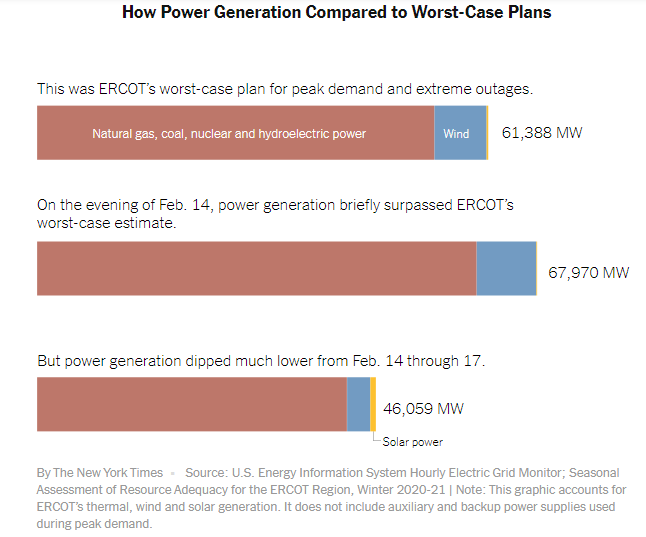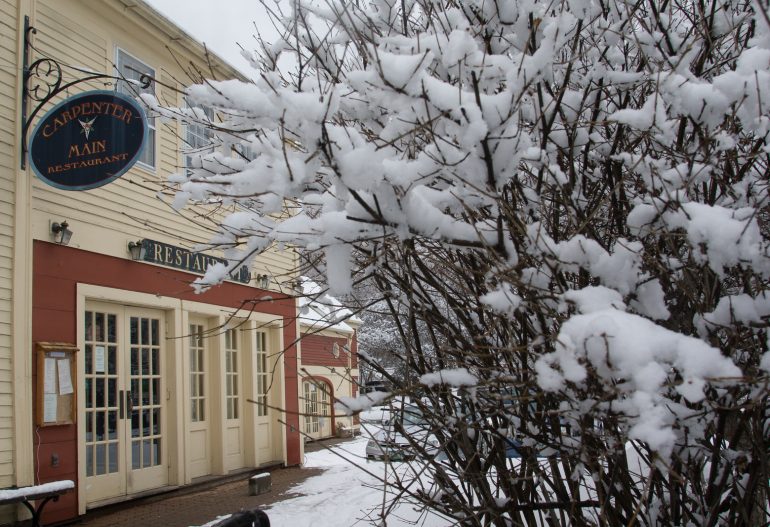The record-smashing, cold-weather outbreak that plunged Texas into darkness last week presents an ongoing human tragedy. While dozens of Texans lost their lives in the powerful storm and its immediate aftermath, tens of thousands more remain without access to reliable heat or safe drinking water. It may take months or even years to repair all of the damage from the snow, ice and bursting pipes that flooded homes and businesses across nearly all of Texas’ 254 counties. There are links at the end of this post where you can donate to help those still suffering from this costliest natural disaster in Texas history.
First, Let’s Cut the Crap!
No sooner did the lights go out in Texas last week than a blame game began about who caused the historic outage. Current and former state officials quickly took to the airwaves and social media to blame “frozen” wind turbines for taking down the nation’s only single-state, stand-alone power grid. They also dismissed their own culpability for 20 years of free-market energy decisions – launched in a deregulatory push by then-Gov. George W. Bush – that left mainly private interests (remember Enron?) to run the show.
While it’s true that some state energy sources — like renewables – have thrived in this deregulated environment, others are now paying the price for putting short-term profits ahead of prudent long-term goals. Another former Texas governor, Rick Perry, defended this practice, writing in a blogpost: “Texans would [rather] be without electricity for longer than three days to keep the federal government out of their business.” (For those who don’t recall Gov. Perry, he once famously forgot the Department of Energy as one of three federal agencies he promised to cut if he became president. Then he went on to lead that agency when Donald Trump became president instead.)
Perhaps the most outrageous comments on the blackout, however, came from the current governor of Texas, Greg Abbott. At the height of the blackout last Tuesday, with temperatures in the state plunging to 40 degrees F below normal, Abbott went on Fox News to declare: “This shows how the Green New Deal would be a deadly deal for the United States of America.” He went on to claim that the cold-weather “shutdown” of solar and wind energy had “thrust Texas into a situation where it was lacking power.” In reality, Abbott knew that more than five times as much natural gas generation – some 25,000 megawatts – had frozen up and had to be taken out of service as the power crisis began. Yet he conveniently left that fact out of his remarks before the national television audience.
Now, Let’s Take the Quiz
With so much finger-pointing and diversionary tactics detracting from the hard truths of Texas’ energy politics, we put together this 10-point quiz to help you sort the facts from fiction:
1. The Polar Vortex that just struck Texas is the costliest weather-related disaster in the state’s history
True. The massive snowstorm and polar weather system that crashed into Texas during the week of Feb. 14-21 caused more insured property damage than from any other natural disaster ever to strike the Lone Star state. Even Hurricane Harvey, the 2017 superstorm that was the wettest weather system in U.S. history, didn’t flood as many Texas homes and businesses as this latest cold weather outbreak did. Reaching all the way down to Mexico, the Polar Vortex left millions of Texans without power or heat for up to five days. At the peak of the event, temperatures were running 40 degrees F below normal and 4.5 million electricity customers were in blackouts throughout the state.
The worst was yet to come, however. After three days of unrelenting, subfreezing temperatures, municipal drinking water systems stopped working and frozen water pipes started to burst, leaving half of the state’s 28-million residents without access to safe drinking water. The final toll from this record-breaking winter storm is expected to exceed that of Hurricane Harvey, which caused $19 billion in insured property losses just three summers ago.
2. Nobody saw this coming
False. While this Polar Vortex was the coldest weather outbreak to strike Texas in more than a century, it was not unprecedented. In the last quarter-century, Texas has suffered two other severe winter storms – in 1989 and 2011. In both instances, state agencies ignored follow-up recommendations from federal regulatory authorities to winterize the state’s generating system to avoid further supply disruptions.
Texas has a huge 125,000-MW installed generating base that produces twice as much power as the next-largest state (Florida). It would be a massive undertaking to retrofit all of these power plants with buried fuel-delivery lines and sheltered spaces for critical operating systems. Lacking protection in the most recent winter storm, nearly half of Texas’ thermal power plants – coal, nuclear and (mainly) natural gas – succumbed to sub-freezing temperatures and couldn’t start up again until temperatures got back above 32 degrees. In most parts of Texas, that didn’t happen for at least three days.
3. Renewables were to blame for the power failure
False. While Texas Gov. Greg Abbott and other state officials initially blamed “frozen wind turbines” and solar arrays for the state’s massive power failure, general lack of winter preparedness was really the main culprit. Wind and solar power account for only about one-tenth of Texas’ overall winter power generation; by comparison, two-thirds of Texas’ winter load comes from natural gas. Half of the Texas wind fleet – which is now one of the world’s largest – did go offline because they weren’t equipped with heaters and blade de-icing equipment (like their more-northerly counterparts). But the remaining operable turbines still managed to crank out 5,000 MW of power during the polar outbreak, equal to about half of what the Texas wind fleet normally produces during the winter peak-load season.
By contrast, the state’s natural gas-fired plants lost five times as much output due to frozen equipment and plugged fuel lines. Some 25,000 MW of gas plants went off-line in the first day of the cold-weather outbreak, triggering an even bigger power emergency as soaring heating demand set new records for winter peak-load demand. Meanwhile, solar’s contribution to the grid more than doubled during the outage period. As the initial snowstorm passed and sunny skies returned over Texas, electricity from solar power actually surged to the point where it briefly eclipsed the state’s wind power output toward the end of the blackout period.
4. Time-of-use rates charged during the blackout caused some ratepayers’ bills to skyrocket
True. As if the shock of the blackout was not enough, some unlucky Texas ratepayers now face shocking electric bills of $5,000 or more for whatever power they did manage to find during the blackout period. In Texas’ deregulated energy markets, electricity wholesalers have made lots of deals with Texas homeowners – ostensibly to save money on their electric bills through adoption of variable rate plans. Such time-of-use rates give retail customers pricing incentives to run their appliances at times when spot electricity prices are low (like scheduling dishwashers to run overnight). But as the Polar Vortex descended over Texas, customers desperate for warmth turned up their electric heaters, not realizing that spot prices were surging to hundreds of times their normal levels, as more power plants dropped out of service. Now, under the fine print of their utility contracts, these unwitting customers are on the hook for these exorbitant electricity bills.
It doesn’t have to be this way, however. Consumer safeguards can be built into such contract agreements to avoid any moves towards price gouging. Moreover, the advent of phone-based apps, which manage home appliances in response to utility pricing signals, adds another layer of consumer protection when spot prices get out of whack.
5. This generating shortfall proves that fossil fuels and nuclear power must remain part of the Texas generating mix
False. If anything, this latest weather episode reveals just how vulnerable Texas’ thermal power plants really are. They have lots of valves, sensors, fuel lines and other moving parts that are exposed to the elements and can seize up in freezing temperatures. Burying these pipelines and sheltering all critical operating systems would be an expensive undertaking that necessarily involves hiking customers’ rates. In a state where market pricing takes the place of long-term planning decisions, it’s no wonder that no one has been looking out for the system’s overall service reliability.
Now, in the aftermath of the latest devastating outage, Texas ratepayers must decide whether the modest savings they gained in the past are worth all of the power interruptions, skyrocketing bills and property damage they are facing now. Under such dire circumstances, does it really make sense to harden the state’s fossil energy plants to stand up to climate change, when they contribute to the underlying problem in the first place?
6. This proves Texas’ go-it-alone approach simply won’t work
False. But it’s not for the reasons you might think. Yes, it’s true that the Electric Reliability Council of Texas (ERCOT) was set up in 1999 to maintain state authority over power management decisions – and specifically to avoid federal regulatory controls. And it’s also true that on matters affecting customers’ rates – like weatherizing power plants – ERCOT has deferred to private-sector interests to make the final call. Worst of all, because ERCOT was set up to avoid addressing interstate commerce, it has been generally cut off from interstate power producers who might otherwise be able to provide backup power when its own system falters.
Despite it all, Texas may still be able to go it alone if really wants to. It’s already the nation’s largest producer of wind power and the second-largest producer of solar power (behind California). Instead of looking across state lines for more generating supply, Texas could double-down on its own production of in-state renewables. But that would also require a major commitment to place more grid-connected storage into Texas’ generating mix — and allow more renewables to flow into the grid from within its own customer base.
7. More battery storage would help alleviate power crises like the one in Texas
True. While batteries aren’t a magic bullet yet for the nation’s power grid, they will play an increasingly important role in balancing power supply and demand that’s critical to avoiding future system blackouts. When temperatures got below freezing in Texas last week, so many utility customers cranked up their electric heaters that the state’s power demand surged 7,000 MW above what the ERCOT system had been planning for in its worst-case, winter peak forecast. That excess demand quickly turned into a 30,000 MW generating shortfall, as Texas power plants themselves succumbed to the bitter cold, triggering an even larger power emergency that led to widespread municipal blackouts.
While 7,000 MW of battery storage to accommodate such demand surges would require a major investment by the ERCOT system, it’s on par with another grid modernization program that Australia already has underway to promote more renewable energy use across its national electricity grid.
8. This is a Texas story. It doesn’t really apply to us
False. While the Texas headlines will fade from national view, it will take months or even years before the state’s recovery efforts fully play out. Whether or not state officials acknowledge that climate change is now a force to be reckoned with, their past experience reminds us of what can go wrong when such vexing long-term issues are put on the back burner. On Wednesday, four of ERCOT’s 16-member board of directors resigned, without acknowledging any fault in Texas’ latest weather fiasco. While they said they were leaving over concerns that they resided in other states, Gov. Abbott welcomed the resignations, having chided the Texas grid operator for its “lack of [winter] preparedness.”
In any event, the timing of this Texas saga couldn’t be much better for the launch of President Biden’s “Build Back Better” plan, which prominently features climate-resilient infrastructure in a $2 trillion stimulus package that he’s about to put before Congress. President Biden wants to modernize the nation’s grid to accommodate more use of renewable fuels and electric vehicles, while also stimulating the creation of millions of new green-energy jobs.
Texas, with its leadership in renewable energy production, could serve as an early litmus test of President Biden’s ultimate goal of eliminating fossil fuels from the nation’s power sector by 2035, and achieving net-zero carbon emissions at the national level by 2050.
9. At least those of us who live in cold climates are ready for global ‘weirding’!
False. Here in northern New England, we’re fortunate to live in a place that’s expected to be more resilient to climate change than most regions to our south and west, and along the nation’s coasts. But the Polar Vortex’s latest invasion of Texas reminds us that global “weirding” – freakish, often-fleeting, weather changes that we can’t fully anticipate or predict – are here to stay. “We are colliding with a future of extremes,” Alice Hill, a former senior climate advisor in the Obama administration, told The New York Times recently. “We base all our choices about risk management on what’s occurred in the past, and that is no longer a safe guide.”
10. If global warming is for real, at least we won’t need to worry about the Polar Vortex anymore!
False. While the Arctic region is warming up twice as fast as the global average, and the polar ice cap is melting at unprecedented rates, this does not mean that winter weather itself is disappearing. Far from it! More likely, the Polar Vortex is a sign of new weather extremes that are disrupting the climate system across the globe. Specifically, the ongoing penetration of warm air into the polar stratosphere may actually be displacing the frigid air mass that normally stays bottled up north of the Arctic Circle. Now, much like a rubber band that’s been stretched too far, the circumpolar jet stream may be loosening up, allowing blasts of Arctic cold air to plunge over mid-latitude regions from time to time.
Madrid, Spain, was also hit by the Polar Vortex and a crippling snowstorm earlier this winter, causing an estimated $1.7 billion in insured losses. Much like a refrigerator door that’s opened to defrost its contents, the Polar Vortex takes this frigid air out of its Arctic environment and vents it into downstream areas. Continental Europe and eastern North America may be two places on Earth that are on the receiving end of this thawing process going forward.
How You Can Help
If you would like to provide assistance to those in Texas still suffering from the latest Polar Vortex weather outbreak, you can reach out to local humanitarian organizations like the Houston Food Bank, the Austin Disaster Relief Network and the San Antonio Food Bank. In addition, Feeding Texas partners with nearly two dozen local food banks throughout the state. You can research any organization on trusted sites like Charity Navigator and GuideStar, which rate nonprofits based on their effectiveness and financial condition. These sites can also show whether the organization’s goals and practices align with your values and beliefs.
Solaflect Energy is your home energy management partner. We help you install clean and affordable solar electricity and battery systems for a more durable and climate-resilient future. Click here to contact us, or email info@solaflect.com, or call (802)649-3700, or text (802)308-3018. Working together, the power is in our hands to make a difference!








